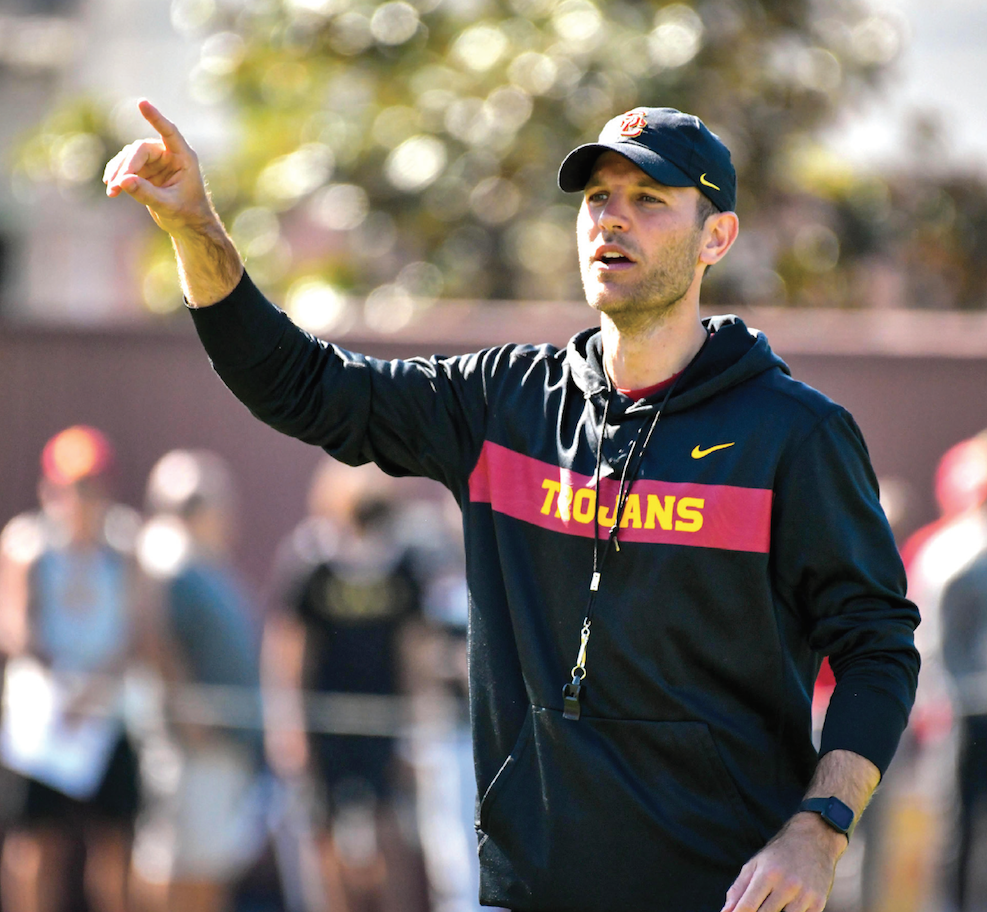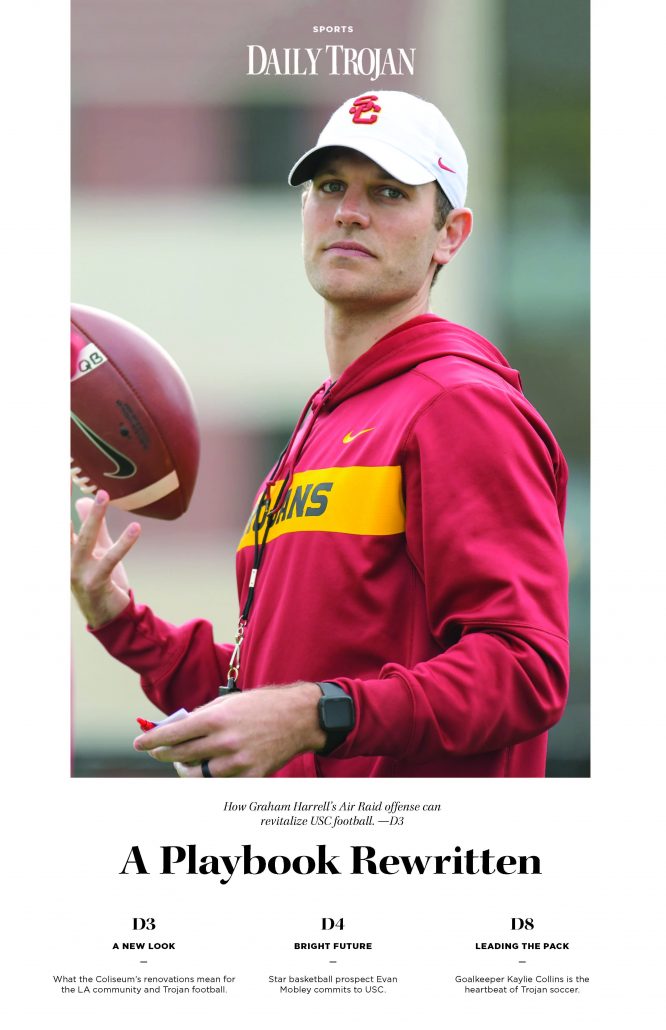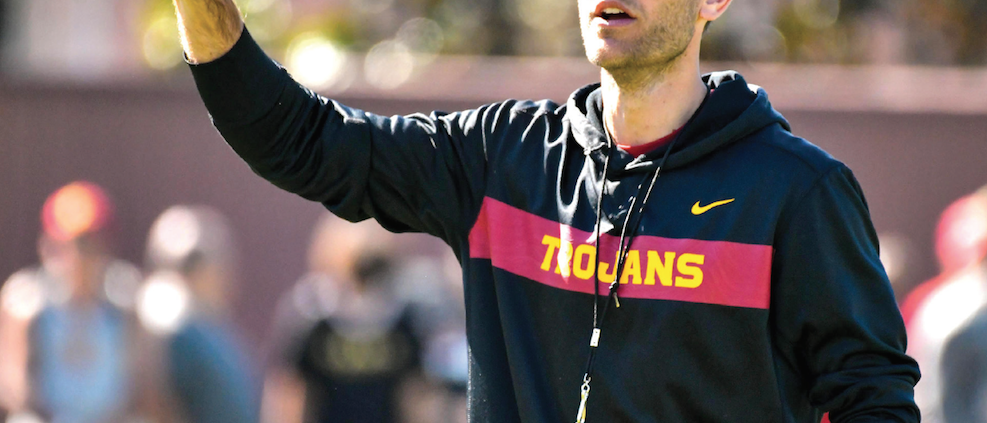Football looks to bounce back with Harrell on board

Following a disappointing 5-7 season that left fans clamoring for change, USC football may finally have what it takes to turn things around under new offensive coordinator and quarterbacks coach Graham Harrell.
After USC capped off a terrible season by blowing a 10-point lead to visiting Notre Dame, major staff changes were inevitable. The Trojans, who finished 83rd in total offense per the NCAA, announced offensive coordinator Tee Martin wouldn’t return and wasted no time in hiring former Texas Tech head coach Kliff Kingsbury as his replacement.
Unfortunately for the Trojans, Kingsbury was offered the head coaching job for the Arizona Cardinals in January and decided to leave college football for the NFL.
Later that month, head coach Clay Helton announced Harrell’s hiring. The former North Texas offensive coordinator is known for his shotgun Air Raid offense that features frequent audibles and is often run without huddling before snapping the ball.
Although the consensus is that sophomore quarterback JT Daniels will lead Harrell’s offense in USC’s Aug. 31 opener against Fresno State, the Trojans have plenty of depth at one of the game’s most crucial positions. Freshman quarterback Kedon Slovis has been a pleasant surprise in fall camp, displaying both arm strength and accuracy.
“Kedon’s a special talent,” Harrell said. “His arm, when that ball comes out of his hand, it looks different. That’s what it’s supposed to look like.”
Perhaps the strongest position group for the Trojans this season will be wide receiver. Sophomore Amon-Ra St. Brown is coming off a 60-reception season, while senior Michael Pittman Jr. averaged 69 receiving yards per game last year. Harrell’s offensive scheme should allow one of the Pac-12’s best receiving corps to make an even greater impact this season.

But USC will need more than just a revamped offense to return to college football dominance. Defensive coordinator Clancy Pendergast leads a unit that must make significant improvements to avoid another disastrous showing.
After allowing just the fifth most passing yards per game in the Pac-12 last season, USC will have to overcome the losses of cornerbacks Ajene Harris and Iman Marshall, as well as safety Marvell Tell III, to the NFL.
Sophomore cornerback Olaijah Griffin has impressed in fall camp and will be counted on to provide some relief along with cornerbacks freshman Chris Steele and redshirt freshman Isaac Taylor-Stuart. While the Trojans have several talented young defensive backs that could make a positive impact, the inexperienced group is likely headed for some growing pains early on.
“[Our offense] took advantage of some freshman corners at times,” Helton said after a fall practice. “They’ll learn from it, and they’ll come back and they’ll be even better.”
The success of USC’s defense is likely to come from its strong defensive line. Redshirt sophomore defensive lineman Jay Tufele, who picked up 23 tackles and three sacks last year, is poised to replace departed linebacker Porter Gustin as the biggest threat in USC’s front seven — though freshman defensive lineman Drake Jackson has announced his arrival in spring camp and is sure to make his presence felt this fall.
Defensive linemen redshirt sophomore Marlon Tuipulotu and redshirt senior Christian Rector led returning Trojans with 4.5 sacks each in 2018 and add to a group that needs to improve after allowing 164.4 yards per game in the Pac-12 last year — the fourth most in the conference.
Whether USC will be able to make sufficient defensive strides remains to be seen — but if Jackson has anything to say about it, the group doesn’t lack confidence. He told the Los Angeles Times in April that the defense would make offenses “feel it” this season.

After committing 96 penalties for 73.6 yards per game last year — worst and second-to-worst in the Pac-12, respectively — USC must avoid shooting itself in the foot, a burden which will fall heavily on the shoulders of the defense.
With that in mind, the team has brought out referees to its fall practices, hoping to help a young squad avoid careless mistakes once the season begins.
“Obviously, it’s great having the refs out here,” Helton said. “They alert us to exactly when the flags are being thrown and what we’re doing, and [we’re] getting real -time information.”
Helton’s seat is as hot as ever even before the season kicks off, and a challenging first half of the Trojans’ schedule will go a long way in determining his future with the program. The Trojans, who have historically dominated at home but dropped their final three games at the Coliseum last year, face three tough home matchups against Fresno State, Stanford and Utah in the first four weeks before hitting the road for two brutal contests against Washington and Notre Dame.
USC needs to use the first six games to prove it can compete with some of the nation’s top schools, or the demands from impatient Trojan fans calling for Helton’s removal will grow even louder.
Many different factors on both sides of the ball have to improve for the Trojans to compete for a Pac-12 title this year, but there is reason to believe that USC football will return to its usual lofty standards sooner rather than later.
Either way, 2019 is bound to be a pivotal year for Trojan football.
Stuart Carson contributed to this story.

